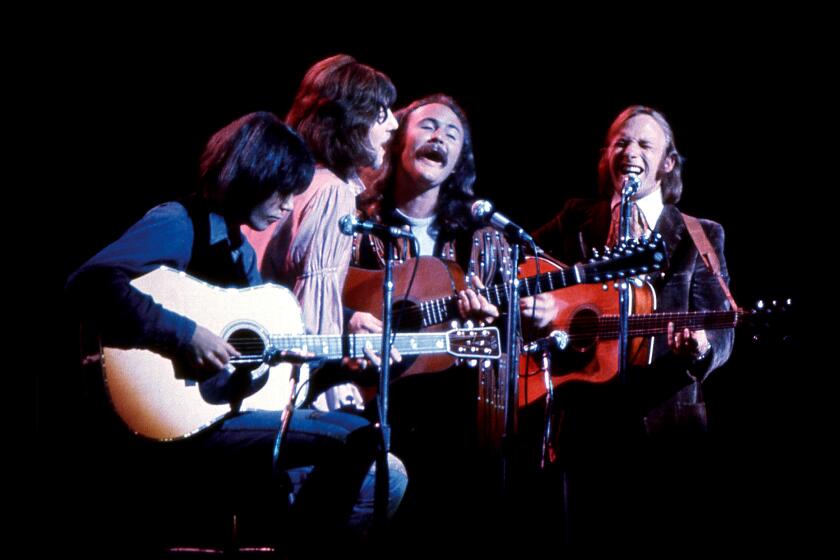In a White Vacuum
- Share via
Sometimes I think the Bowers Museum of Cultural Art might as well expand its store to fill the entire premises and forget about trying to be a museum.
The Bowers’ latest offering, “Splendid Heritage: Masterpieces of American Art from the Masco Collection” (through Aug. 10), suggests once again that this institution believes it carries out its mission merely by displaying objects from various cultures, without bothering to tell us anything substantive about them.
For some reason--some say it’s a bid for acceptance by the high rollers of Orange County’s society world--the Bowers of the ‘90s is trying to be an art museum, as demonstrated by the “cultural art” appendage to its original title.
As such, it steadfastly refuses to acknowledge any obligation to treat material from an anthropological or properly ethnographic point of view--an emphasis that would have made the Bowers a major educational resource and a genuinely unique county institution.
It appears that no one told the Bowers powers that respected art museums do much more than simply put attractive objects in well-lighted cases.
*
In the case of “Splendid Heritage,” the lack of explanatory labels for objects made by numerous Native American peoples from the Great Plains, Great Lakes and adjoining regions seems particularly odd, given the involvement of Native American scholars in the exhibition. It was organized by the Wheelwright Museum of the American Indian in Santa Fe, N.M., from the collection of Masco Corp., a home-products manufacturer in Taylor, Mich.
Sadly, it is possible to emerge from the display of 45 beaded bandoleer bags, wooden clubs, deerskin moccasins, buffalo hide shirts and the like without forming any concrete notion of the daily lives and beliefs of their makers. It’s as if a vague appreciation for bright colors, eye-catching patterns and labor-intensive handwork is all a viewer needs.
The catalog offers more information, but in annoyingly undigested form, as raw transcriptions of off-the-cuff comments by three experts tossing out tidbits of miscellaneous information. At best, the scholars’ lack of consensus about the origin, meaning and use of many of the pieces indicates the still-rudimentary state of Native American studies.
But the big picture is missing. This showcase of a portion of a corporate collection has no thesis, no point of view except the self-promoting description of the artifacts as “masterpieces.” That word--so often used as a promotional tag for European painting exhibitions--wrongly shifts the emphasis from the Native American makers of these objects to the supposedly definitive value judgments of whites.
*
Lacking a historical or ethnographic context for these pieces, a viewer is likely to latch on to whatever looks unusual and intrinsically appealing. One is the Horse Memorial carved sometime between 1890 and 1920 by Joseph No Two Horns, a Hunkpapa Lakota Sioux from North Dakota who died in 1942 at the age of 90.
With a winsome horse’s head at one end and a single hoof at the other, this curving tree branch--painted to simulate the color of a blue roan--encapsulates the personality and the usefulness of the horse in a single, fluid arc.
According to the catalog, No Two Horns carried the horse effigy--which probably memorialized his own battle-weary steed, complete with gashes in its neck--in dances reenacting war victories. He apparently sold some of his horse effigies to outsiders, a fact the catalog essay might have elaborated on: What does it mean when an object produced for personal, ceremonial use becomes a commodity?
There is one painting in the exhibition, a delicately rendered series of war scenes on muslin, made sometime between 1900 and 1920 by His Battle, a member of both the Hunkpapa and Sans Arc Sioux. (His Battle’s white brother-in-law dubbed him “Jaw.”)
His style has the charm of a schoolboy’s notebook drawings, with rows of horses, stiff figures, some wearing flat red capes, and triangular clusters of small marks signifying gunfire traveling to its target.
If all the brave guys seem suspiciously similar, that’s partly because they’re all self-portraits. By the time he made the painting, Jaw was in his 50s or 60s, looking back on decades of horse stealing and other derring-do. “Jaw to the rescue,” he wrote proudly above one depiction, beset by a phalanx of barely sketched-in enemies.
On July 27 from 2 to 4 p.m., Little Crow, executive co-director of the American Unity Church and professor emeritus of American Indian Studies at Cal State Long Beach, will give a much-needed lecture about the cultural context of the exhibition. Admission is $5.
* “Splendid Heritage: Masterpieces of American Art From the Masco Collection,” through Aug. 10. Bowers Museum of Cultural Art, 2002 N. Main St., Santa Ana. Hours: 10 a.m.-4 p.m. Tuesday, Wednesday and Friday-Sunday; 10 a.m.-9 p.m. Thursday. Admission: $6 general; $4 students and seniors; $2 children 5-12, free for under 5. (714) 567-3600.
More to Read
The biggest entertainment stories
Get our big stories about Hollywood, film, television, music, arts, culture and more right in your inbox as soon as they publish.
You may occasionally receive promotional content from the Los Angeles Times.










